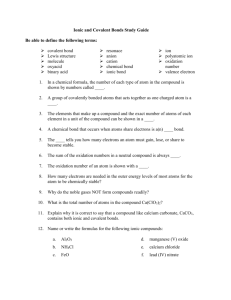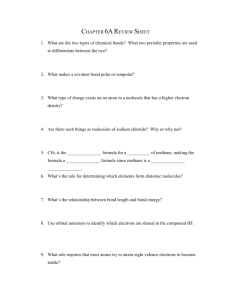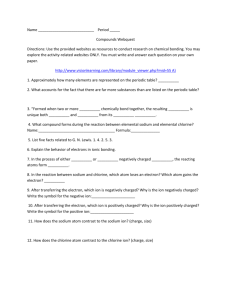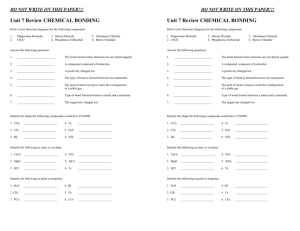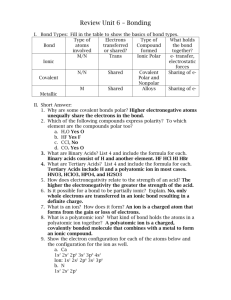Chem Study Guide 2015
advertisement
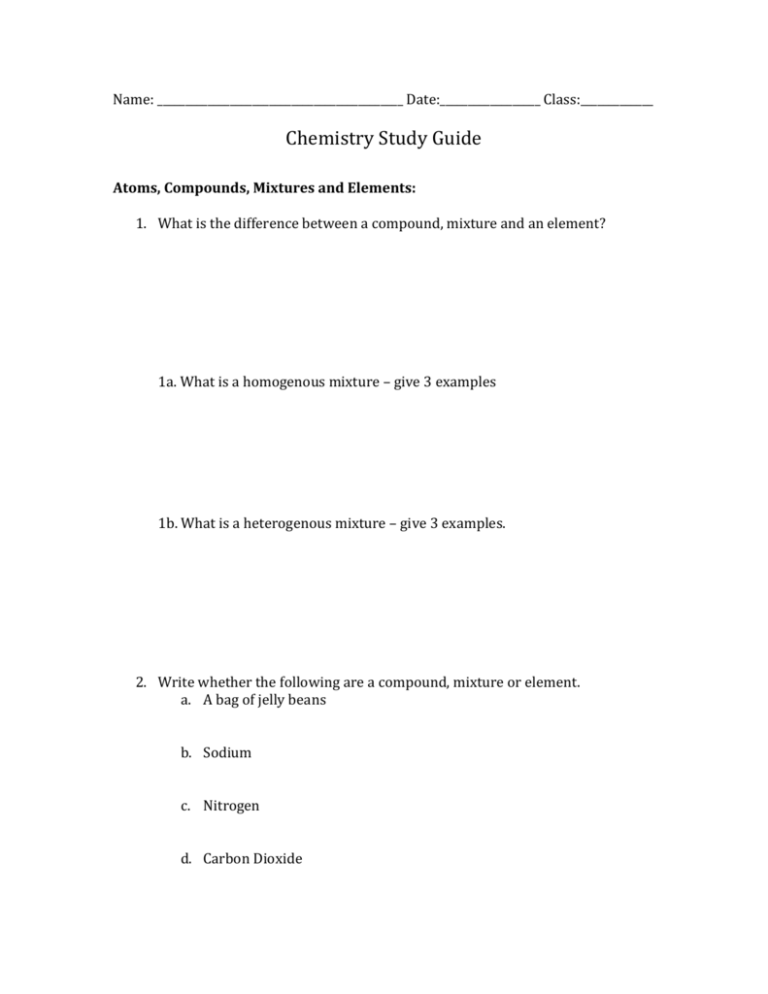
Name: ____________________________________________ Date:__________________ Class:_____________ Chemistry Study Guide Atoms, Compounds, Mixtures and Elements: 1. What is the difference between a compound, mixture and an element? 1a. What is a homogenous mixture – give 3 examples 1b. What is a heterogenous mixture – give 3 examples. 2. Write whether the following are a compound, mixture or element. a. A bag of jelly beans b. Sodium c. Nitrogen d. Carbon Dioxide e. Sand f. Air 3. What is a scientific theory? 4. Fill in the following chart with the date, theory and drawing of the model for each scientist/ theory. Date of Discovery Theory Discovered Model of Theory John Dalton J.J. Thomson Ernest Rutherford Niels Bohr Cloud of Electrons Modern Atomic Model 5. What is an electron; and where is it located in an atom? 6. What is a proton; and where is it located in an atom? 7. What is a neutron; where is it located in an atom? Atoms Bonding and Periodic Table: 8. Draw a Lewis Structure and Bohr Model for the following elements. a. Hydrogen b. Calcium c. Bromine d. Carbon e. Potassium 9. What role do valence electrons play in the formation of compounds from elements? 10. Summarize how the periodic table is organized. Be sure to use the words period and group. 11. Use the terms below to label the following Symbol Atomic Number Atomic Mass 18 Ar Argon 39.948 12. What are the elements in Group 18 called and how reactive is this group? Explain this reactivity in terms of the number of valence elements. Ionic Bonds: 13. Fill in the blanks: When an atom loses an electron, it loses a ___________________________ charge and becomes a ___________________________ ion. When an atom ___________________ an electron, it gains a ___________________________ charge and becomes a ____________________________ ion. 14. Define the following terms a. Ion: ________________________________________________________________________________ ________________________________________________________________________________ b. Polyatomic ion : ________________________________________________________________________________ ________________________________________________________________________________ c. Chemical Formula: ________________________________________________________________________________ ________________________________________________________________________________ 15. What is an ionic bond? For problems 16-20 use a dot diagram to show how the elements combine to form an ionic bond. REMEMBER to show the charge of each element AFTER they bond to form ions. (You might need to use the ion chart in the book!!!!) 16. Sodium+ Iodine 17. Magnesium + Nitrate Chemical Formula:_______________________ Name:_____________________________________ 18. Potassium + Sulfur Chemical Formula:_________________________ Name:_______________________________________ 19. Boron+ Oxygen Chemical Formula:_________________________ Name:_______________________________________ Chemical Formula:_________________________ Name:_______________________________________ 20. Ionic compounds are hard, brittle crystals and have high melting points. Why do they have high melting points? 20a. Name the following compounds: CaO _______________________________________________________________ LiSO4 _______________________________________________________________ Mg3(PO4)2 _______________________________________________________________ K3N _______________________________________________________________ 20b. Give the chemical formula for the compounds below: Calcium Sulfide: _______________________________________________________________ Ammonium Fluoride : _______________________________________________________________ Aluminum Chloride : _______________________________________________________________ Sodium Carbonate: _______________________________________________________________ Covalent Bonds 21. What is the force that holds atoms together in a covalent bond? 22. What is a covalent bond? 23. Complete the sentence: A neutral group of atoms joined by covalent bonds is called a(n)______________________________________. 24. What are molecular compounds and name three characteristics of them. For problems 25-29 use a dot diagram to show how the elements form a covalent bond. 25. O2 26. NBr3 27. H2SO4 (Sulfur is in the middle) 28. C2H2 29. For the following pairs of elements state whether they would form an ionic or covalent bond. a. Lithium + Oxygen ____________________________________________________________ b. Sulfur + Chlorine ____________________________________________________________ c. Hydrogen + Chlorine ________________________________________________________ d. Sodium + Nitrogen __________________________________________________________ e. Carbon + Fluorine ___________________________________________________________ f. Magnesium + Fluorine ______________________________________________________ g. Potassium + Phosphorus ___________________________________________________ Observing Chemical Change 30. What is matter? 31. State whether the following are physical or chemical properties a. Water boils at 100°C _______________________________________________ b. c. d. e. The ideal pH for fresh water is around 8 _________________________________ Aluminum is shiny _________________________________________________ Iron will rust ______________________________________ The melting point of chlorine is -101.5° C _________________________________




